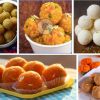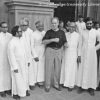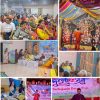Goa is abuzz with excitement as vintage bike and car owners, users, collectors and fans are decking […]

RS45 PER PLATE OF TWO RAGI IDLI!
Eating is Fun / Eating is Yuck! - A variety food column, Jan 20- Jan 26 2024, Life & Living January 19, 2024At Sodexo’s Yoo canteen at GMC: The Aarogyum menu offers ragi idli with sambar, Rs45 per plate of two idli. Ordinary rice idli is priced at Rs33. The new menu envisions millets playing a bigger role in patients’ food, hopefully! With all the promotions going on millets have become costlier.
By Tara Narayan
WELL, with all the promotions, festivals and all kinds of middle men jumping into the fray of celebrating the millets of India, what do you expect! Suddenly, the initial thrill of getting ragi idli-sambar for breakfast for me at the GMC’s Yoo canteen every morning has faded. For although the idli are nice and big sometimes, most often they’re small and hard and only doused in minimal sambar…no chutney. How much? Rs45. The rice idli are only Rs33 per pair plate. Expensive, not many buy the ragi idli, only I do even if it pinches and these days I’m stricken by conscience!
I buy them pretending to myself that the hubby who is a patient in a GMC ward will condescend to eat them, knowing from experience that he won’t because “my mother choked with me ragi day in and day out when I was growing up!” So today and in the last 24 years he never lets me interfere with his rotten eating habits. He likes his egg omlet and won’t let me interfere if he knows I am interfering and presumably treating him like my guinea pig! That’s how complex life can become between an over-married couple if I may call it that…and I tell myself, too bad, one may not drag a donkey to the water to make him drink or some such things.
To my way of thinking but not his, one must always in life be grateful for small mercies and perhaps now and again a big mercy if it comes one’s way– just be sure to recognise it, that’s all!

I’ve already said enough about the GMCs Yoo canteens, no more. I wish I could re-design its menu for it every morning, noon and tea-time. For example, I wish the slim bread rolls they stock for Rs25 each would be filled with honest peanut butter, instead of some sugary synthetic cream! I don’t know where they get these slim cream bread rolls from, must ask them; the plain ones I see in most bakeries of Goa are too hefty sized for my occasional purposes and not soft enough, although what evils go into all that softness!
The only thing to do if one must eat them is to fill them up with nice things like peanut butter, homemade garlic aioli or butter and julienne-cut cabbage and carrot coleslaw and then one may pretend the bread roll is not half so bad , can’t do much damage to body beautiful. Don’t laugh. The things we think about nowadays to pretend one is making some changes for the better in one’s eating habits … life’s soap operas are like that only. We win some, mostly lose a lot.
Stupid way to think and compromise but I’m doing it all the time and I’m sure so are a lot of folk out there. The entire infrastructure of industrial foods has to be dismantled and this will happen only when enough people boycott today’s diabetes and heart disease promoting industrial foods, and we have better affordable options (affordable by the common working people, not the rich folk who oftentimes don’t know any better either), and know the difference between what’s good, bad, ugly. Currently as I see all around me most of us live like we don’t want to know and if we know we don’t care. Like we hate ourselves instead of love ourselves and our children…think about all this.

WHICH reminds me! Out at a store recently I spied these new Nestle packets of Masala and Tomato Millet – so millets now have become commercial in industrial formulae and packaging: the copy on these packets says “high in fibre, 30% lower in calories and no added preservatives.” More: “Masala millet is a delicious blend of bajra, barley, veggies and spices” and this: “Bajra is a climate smart crop and requires less water to cultivate.” Thank-you, like we don’t know! I bought a packet of the Masala Millet and pouring a cup of cold water into it, let it soaked a bit and then cooked it…nice, spicy. As good or bad as all the packet instant noodles and oats, Rs30 per 40g packet. A lot of smart copy so tiny I need a magnifying glass to read it all! All our urban eating out habits create our first problem now: Food litter, and we don’t feel guilty at all. We are a civilisation of unsustainable lazy desires and pay the price for it till doomsday.
FINALLY, a bit of good news. Out at some five-stay hotel press conference I saw these upmarket tea bag packets: Karma Kettle Green Tea, the copy beneath reading “Staple Free Teabag.” Instead of the usual zinc staple pins most teabag come with to stop the tea residue from leaking when you dip it in hot water or hot milk…for some refreshing dip dip tea to soothe some cold feelings. I usually resent these zinc staples or any kind of staples in the food business local or global, they can prick and if they varnish somewhere in your food, you may get into trouble. It happens with seniors citizens using tea bags or stapled delivery foods at home. So don’t say I’m just kit-pitting as usual.

Look for these Karma Kettle green tea bags if you’re fussy like me! Although these days I’ve just taken to boiling some saunf (aniseed) in hot water, straining and drinking the beautiful green water tea…one or two cups and I feel liberated from life’s morning woes. Actually, one may do these water teas imaginatively using even coriander seeds, a clove or two, green tulsi leaves, lemon grass, even grated ginger (although this may need a bit honey stirred in to sweeten for palatability, the enzyme activity of honey is lost of course if you put it in hot liquid)…try camomile flowers, blue pea flowers, just a dry pod of cardamom and so on and so forth. I’m happy with a teaspoon of “valyari” as we call it in Gujarati, or “saunf” (Hindi), or “aniseed” (English). Get the thinner, naturally greener Lucknowi saunf which is more expensive if you can, ait’s a bit hard to find. Online orders too sometimes don’t give you fresh stuff.

The goodness of saunf is that it is some kind of a heart tonic and I’m seeking to mollify my crock heart these days! Saunf (also called fennel) is reportedly good for diabetes and cancer and beneficial for the liver, antibacterial, antifungal, antioxidant. In still traditional Guju homes it’s considered the done thing to pop some “valyari” in your mouth for chewing after a heavy noon meal, although children will acquire a craze for it for any time popping. The saunf or aniseed/fennel is usually rubbed with a salt-turmeric water and roasted gently for crispness. It’s yummylicious and very agreeable. Of course you may buy it at some of the Guju stores out in the distant Western suburbs of Mumbai like Vile Parle (West, East), Santa Cruz (West, East), Ghatkopar, and wherever there’s a sizeable Gujarati settlement. I still remember the Bombay that I used to love and still love in memory out here in Goa! The Gujus have a whole host of post-meal digestive something like “valyari, dhana-n-dal (coriander seeds), ajmo ane tal (thymol and white sesame seeds) and some more, more about them another time here. Good stuff all this and not just for nothing. It’s all part of the real good life we need to discover or re-discover for our own good health!















